A behavior that isn’t easy to photograph well in an extended series.
On occasion I like to photograph diving waterfowl in an attempt to capture an extended series of the behavior. I like seeing the progression of the photos in sequence, I enjoy the considerable challenge of doing it well and it’s good training for the ol’ reflexes. Two days ago I had such an opportunity with a particularly handsome and up-close Redhead drake so I accepted the challenge.
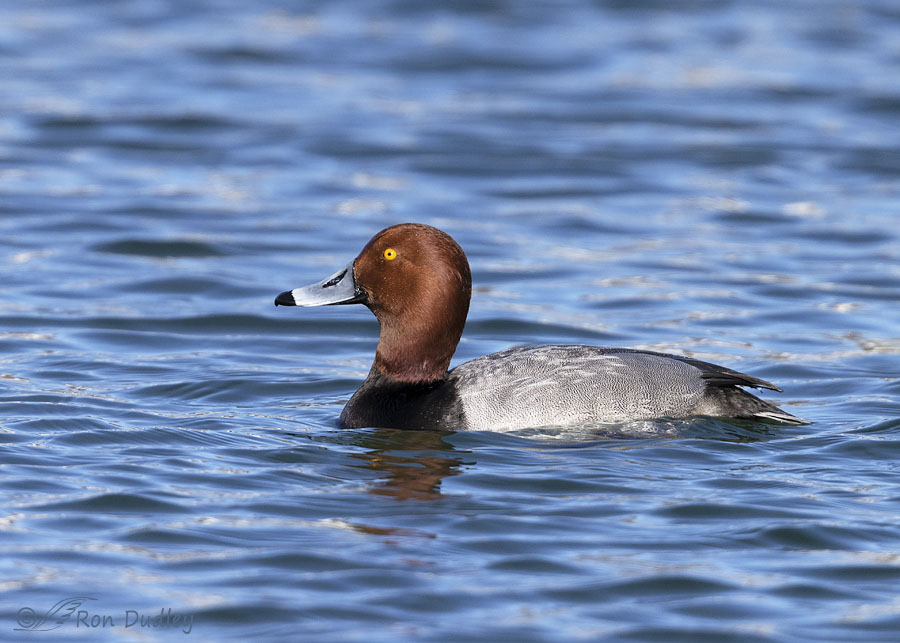
I played cat and mouse with him for quite a while as he was feeding (long enough for me to take 658 photos) and I got quite a few diving sequences but in most of them he wasn’t broadside to me or I had less than ideal light on his face and eye. This is the series I liked best.
The first ten photos are presented in the order they were taken and there are no skips.
One major challenge is anticipating their dive. Because it happens so fast it’s very easy to miss its beginnings or fire off way too many shots before it starts. I’ve learned to watch for this blank forward stare as a signal that they’re thinking about diving but the amount of time they hold the stare is highly variable so you can sometimes waste many dozens of shots before the dive actually begins.
When that happens I always feel faked out so I’ve learned to look for something else (it’s subtle) before I begin firing off a burst.

What I look for is this slight vertical extension of their neck and head at the very beginning of the dive. If you compare this shot to the previous one it should be noticeable, but just barely.
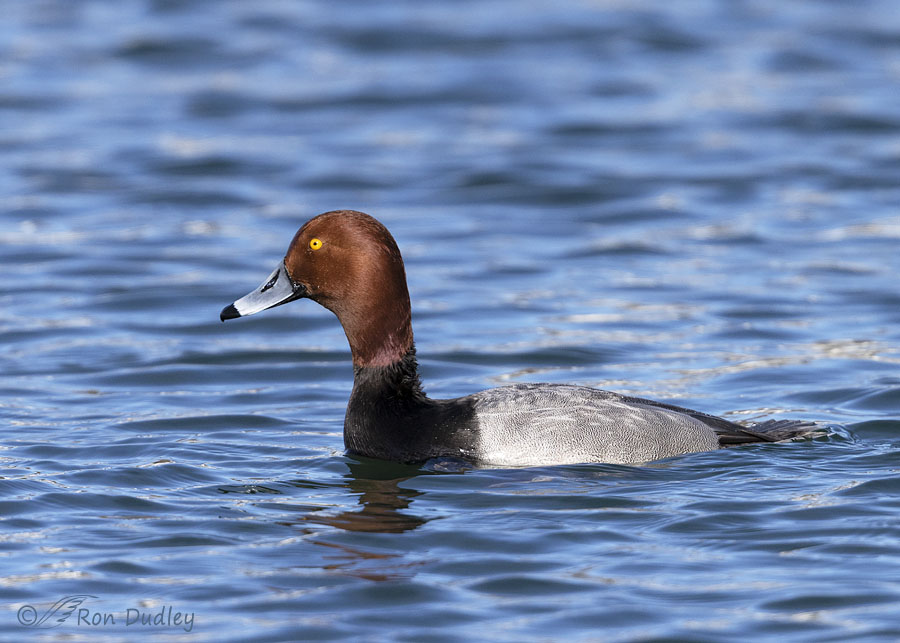
When I see it beginning to happen my burst begins.
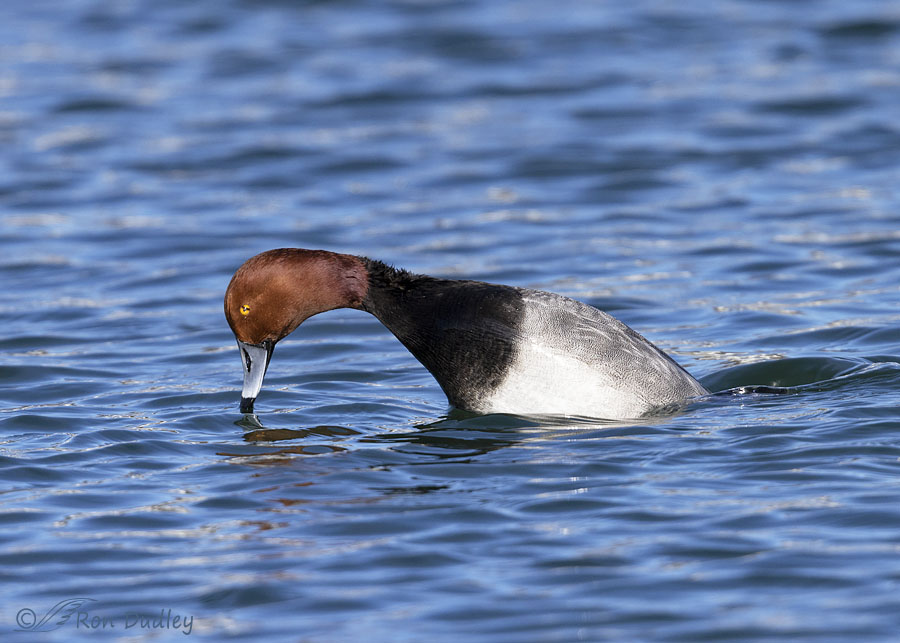
One of the reasons I liked this series over the others I got is that I caught him just as the tip of his bill was beginning to enter the water. For some reason that’s always a goal of mine in diving sequences.
You’ll notice that he’s beginning to close his nictitating membrane. I get the impression that they close their membranes just prior to impact with the water and then open them again underwater while they’re looking for food.
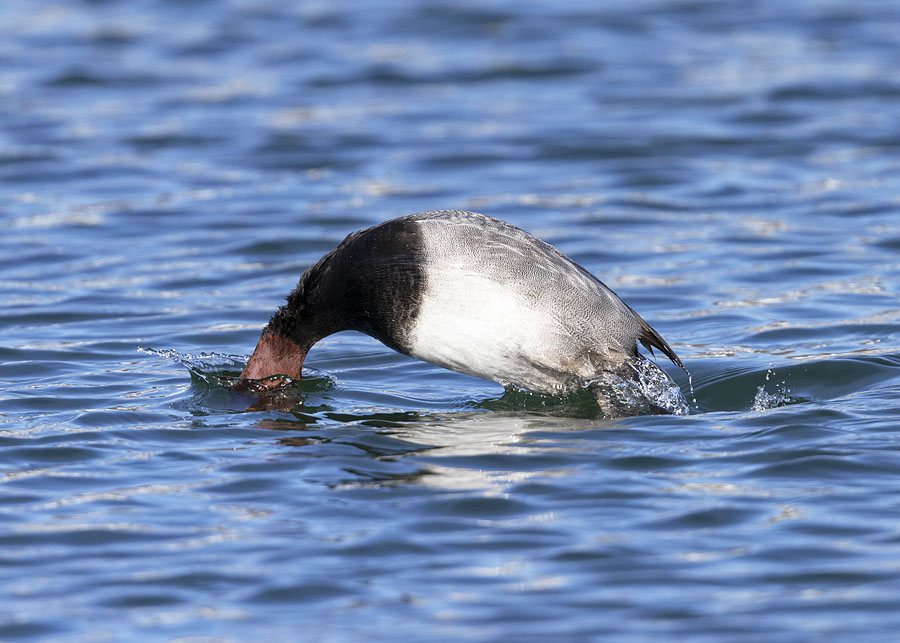
I like the arch of his body and the depression in the water directly behind him.
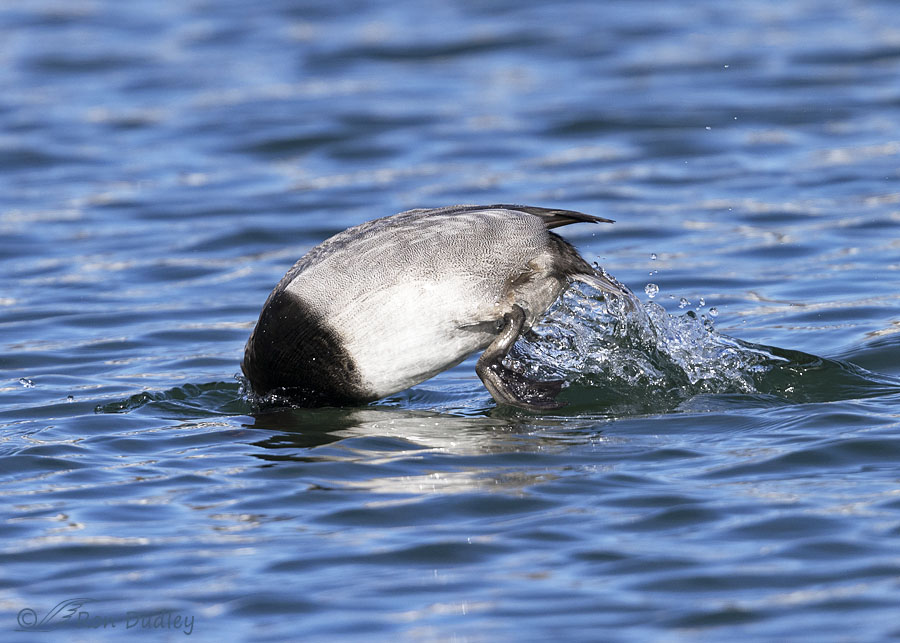
Surface tension and vacuum sure pulls…
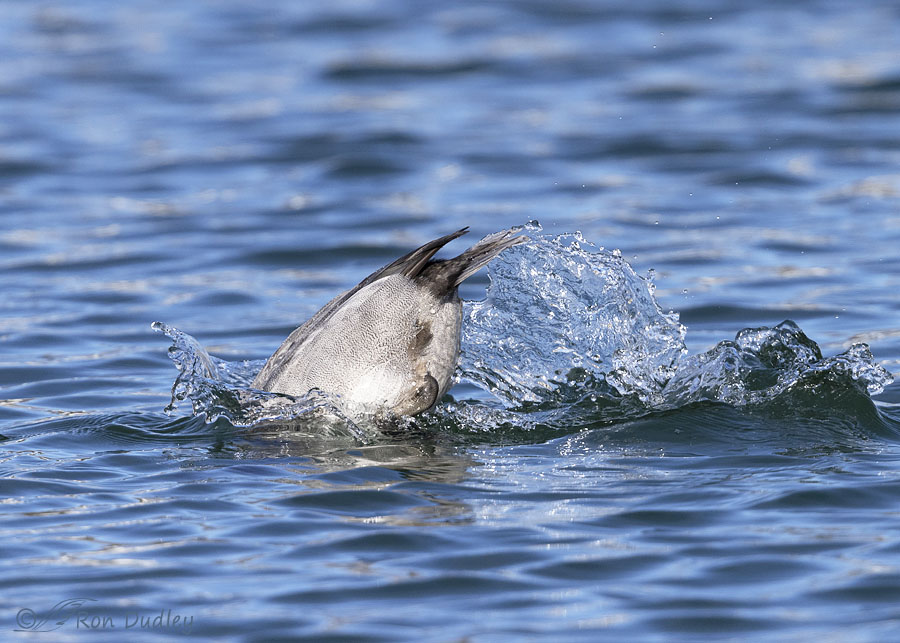
a lot of water above the surface.
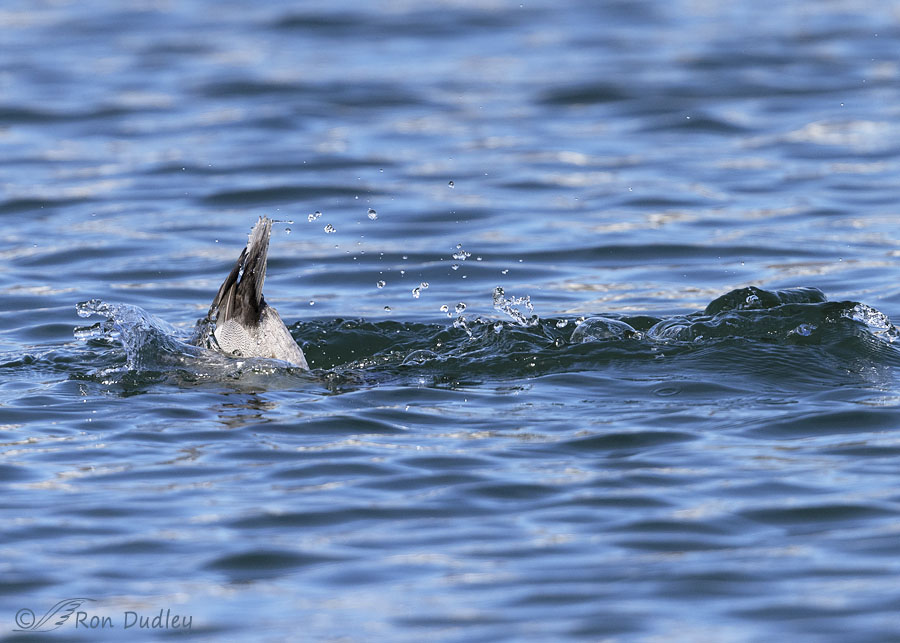
Beginning to disappear beneath the surface.
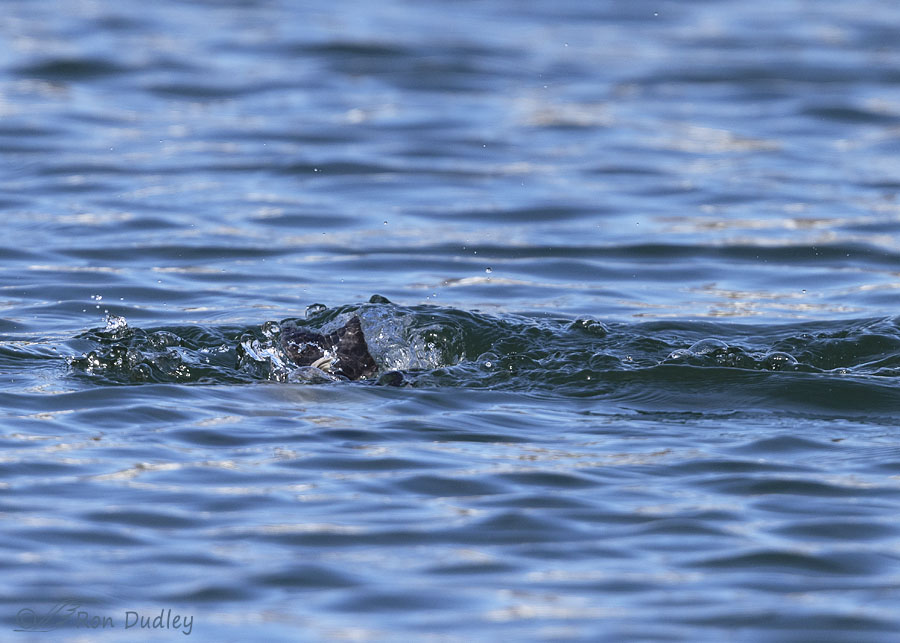
But he’s not gone yet. We still see the very tip of his tail.
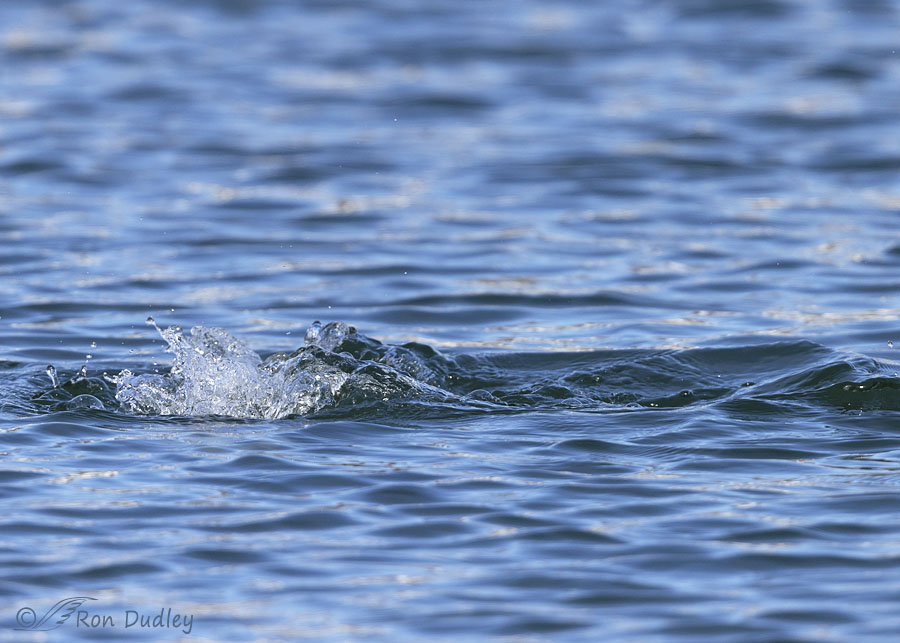
Now he’s gone. Even though there’s no portion of a bird to be seen in a shot like this I’m weird enough to like seeing the water splash where he disappeared and the depression in the water where his body had been just prior to the dive.
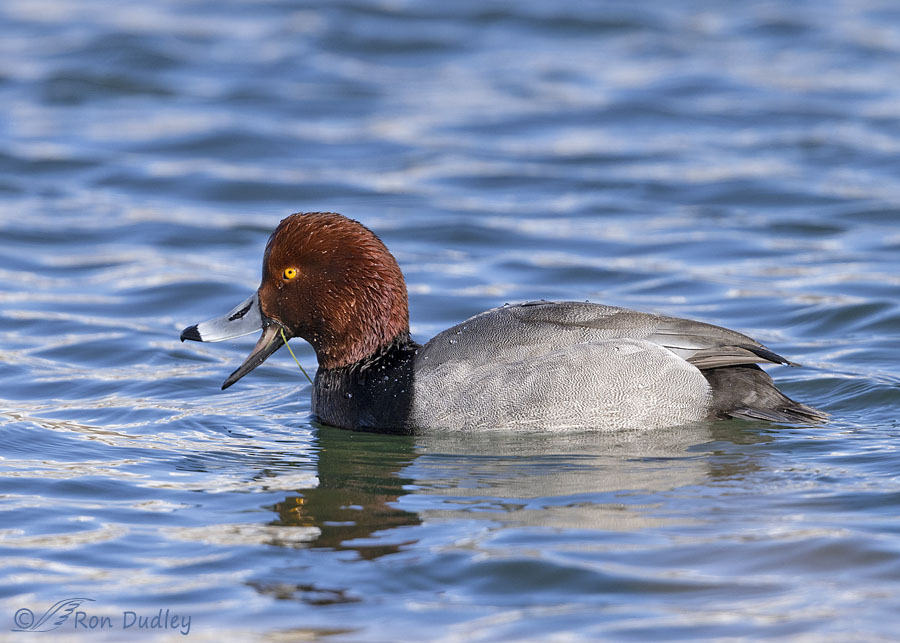
When he’d come up from feeding he often looked like a bovine chewing its cud, in part because of the slightly sideways alternate movement of his upper and lower mandibles as he manipulated his food. I guess for me it’s a yin and yang type of thing.
I may be entertained by sequences like this more than my readers are but I decided to post the series and take the chance.
Ron


Wow. (speechless)
I’ll take that as a positive. Thanks, Cheryl.
Fascinating sequence, Ron. One wonders if they sense what they are diving for or it’s literally a fishing expedition.
I do like that you thought to include the splashing water sans duck. Adds an important element to the whole series.
Thanks for appreciating the duckless photo, Lyle. To be honest I felt a little silly including it.
Thanks, Ron, for the link to your June 2022 post – that one was so good with the beautiful water colors. There is a subtle difference, isn’t there? And also looking at this series – the post-dive look is different. So interesting!
As a vet tech, watching for subtle face changes was always important – a cue as to how my patients were doing (especially with cats). Neat to know same holds with ducks – though a tad more difficult!
Wow, wow, wow! Besides the perfection of the visual series, there’s the perfection of the analysis accompanying it. Per Kris Eberhard’s comment – now we want to see “the mammal behind the lens” (like the kid’s book “If You Give a Mouse a Cookie…..). I doubt there is a “blank stare” in that mammal! The blank stare and the SO subtle shift in the neck – once again the Artist is teaching us how to see. Thank you!
(Any chance of a “relaxed, not going to dive” photo? It’d be neat to see the difference in the eye.)
“Any chance of a “relaxed, not going to dive” photo?”
Carolyn, this one was pretty relaxed.
https://www.featheredphotography.com/blog/2022/06/22/redhead-when-the-water-colors-steal-the-show/
A wonderful series we wouldn’t see much of without your camera and skills. Never have concerns about posting anything you find interesting or entertaining. If it’s of interest to you, I’m sure most of us will find of value as well. Who cannot be entertained and fascinated by bird behavior?
“Who cannot be entertained and fascinated by bird behavior?”
Dan, some folks are far more interested in “pretty photos” of birds than they are in behaviors. Go figure…
Great series. I love the arch. Great light too. Many of the diving ducks follow this pattern. I have noticed with some their back is usually turned toward the sun so they create a shadow on the water surface. I guess like us they don’t like looking into the sun and bright reflection. It makes it hard to get light on their face. I like you, try to catch that moment. I have been trying with the mergansers. Their dive and initiation is quite different. I wish they did an arch, theirs is low on the water line, the last bit you see is a tail often straight up in the air above the water. It is all very fast!
April, I agree – mergansers dive even faster than Redheads, with no warning that I’ve been able to determine.
It is a tough challenge and you captured it well!
Thanks, Bruce.
Wonderful sequence! Seeing the effects on the water and your explanation in these still photos is both informative and interesting. One more thing to look for when watching ducks
Thank you, Catherine.
What was the Tom Cruise movie with the famous line, “You had me at hello”, well you had me at hello on this series. I really like diving photos and have taken many, but with none as good as these. Your skills and the R5 make a dynamic duo for sure. I’m not sure if my 85 year old eyesight can pick up that slight vertical extension, but next time with the Redheads I will give it a try. I can see it in the photos here, although as you say, it is just barely noticeable.
For many years here I could never find Redheads, but over the past couple years they have become more plentiful. Beautiful ducks.
I have always thought the term Drake just applied to male Mallards, but you frequently use it with other male ducks. What is the origin of the term and can it be used with all male ducks?
Thanks for the very kind words, Everett. The movie was Jerry Maguire.
Yes, any male duck can be called a drake. Before I got into birds I always thought drake only went with Sr. Francis…
I don’t know the origin of the term.
Wonderful to get to see! Thanks so much!!
Mary
Thanks, Mary.
Fascinating series ! Too bad your camera will never capture the animal behavior that really knocks ME out, which is the patience and persistence of the mammal behind the lens, then “combing and choosing”, as Michael notes, amongst such a wealth of behavioral capture……I hope you’ve made some
formal arrangements for the someday transfer of your files to a museum or
ornithological institute ?
Kris, the taking is fun but the combing and choosing is a PITA.
Nope, no formal arrangements.
This is a little “off topic” of your post, but will the increased snowfall in the West this year add to the level of the Great Salt Lake ?
It’s already helped, Gary. Last I heard the lake has already risen nearly two feet. It’s a drop in the bucket but at least it’s a plus instead of a minus.
We should get more benefit from this winter’s bounteous snow by late spring, if the politicians and the industrial and agricultural interests allow it to happen. A very big IF…
Fantastic series Ron ! My eyes would nearly be keen enough to notice the difference between photos #1 and #2 in the field but I certainly will look for the stretch illustrated in the neck in photo #3.
Thanks, Gary.
You did it again. That is an amazing photo study. This will always come to mind whenever I see a duck dive.
Regarding the slight vertical extension of the neck as a clue, if you are referring to the first two photos I cannot see a difference between the two. You have a finer eye than I do.
The other thing I am impressed with is your patience. Sitting there and taking 658 shots is one thing, but combing through all those to pick these gems out is quite another. Doing rapid fire is a great way to catch the perfect photo(s), but reviewing later on is a taxing task.
Well done Ron!
Michael, you can’t see much of a difference between the first two because there isn’t much – it’s barely noticeable. More of the extension can be seen in the third.
For me it takes little patience to take that many shots – the action is actually exiting. What takes patience is the reviewing and culling, as you obviously realize.
Thanks very much.
Fantastic series, Ron!!! I never realized that there would be a visible depression in the water where the body had been. Thanks for sharing the whole series!
Well, if you’re weird most of us must be wird too, so you’ve company. Fabulous series! Love the neck extension and will definitely look for that to improve my own success rate. Love too the depression in the water and the lovely, sparkly splashes (and yes, I confess to having magpie blood). Only thing I’m wishing for was a shot of the prey but I guess one can’t have everything all the time and you have certainly given us shots of that type on other occasions so count me a well-sacastified follower.
Granny Pat, although Redheads do eat invertebrates at certain times of the year, their diet is dominated by plants so I’m sure there was no “prey” involved. You can actually see some of the ‘salad’ he was eating hanging out of his mouth in that last shot.
Enjoyed your “magpie blood” comment.
Thanks, Diane.
Luv the series, Ron….. Dynamics of the water as he moves through it also interesting. One would never catch it all just “watching”. I wouldn’t have thought of them “chewing” and having side to side motion in their bills. Always something new to learn about our “fellow travelers” on this planet.
Dynamics of the water as he moves through it also interesting. One would never catch it all just “watching”. I wouldn’t have thought of them “chewing” and having side to side motion in their bills. Always something new to learn about our “fellow travelers” on this planet.
Thanks, Judy. I’m sure he wasn’t actually chewing, it just looked like it.